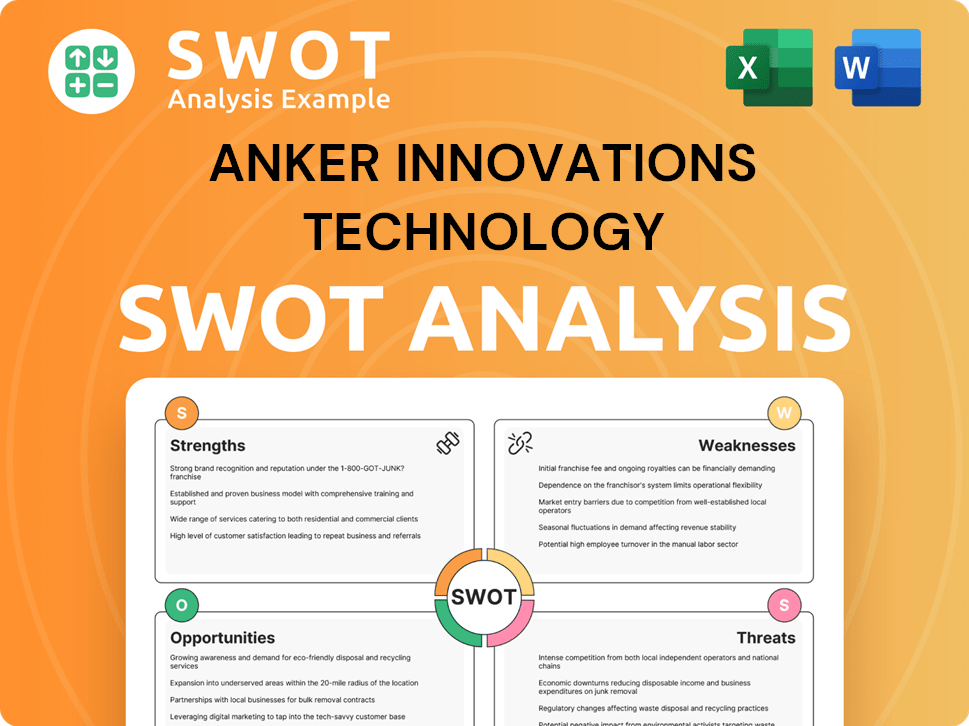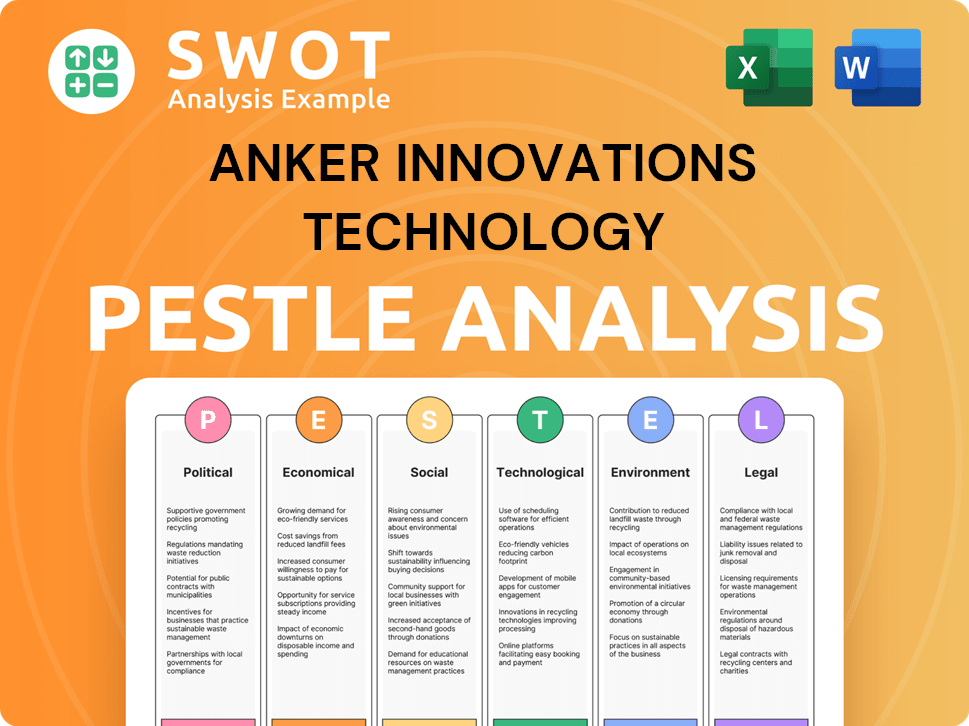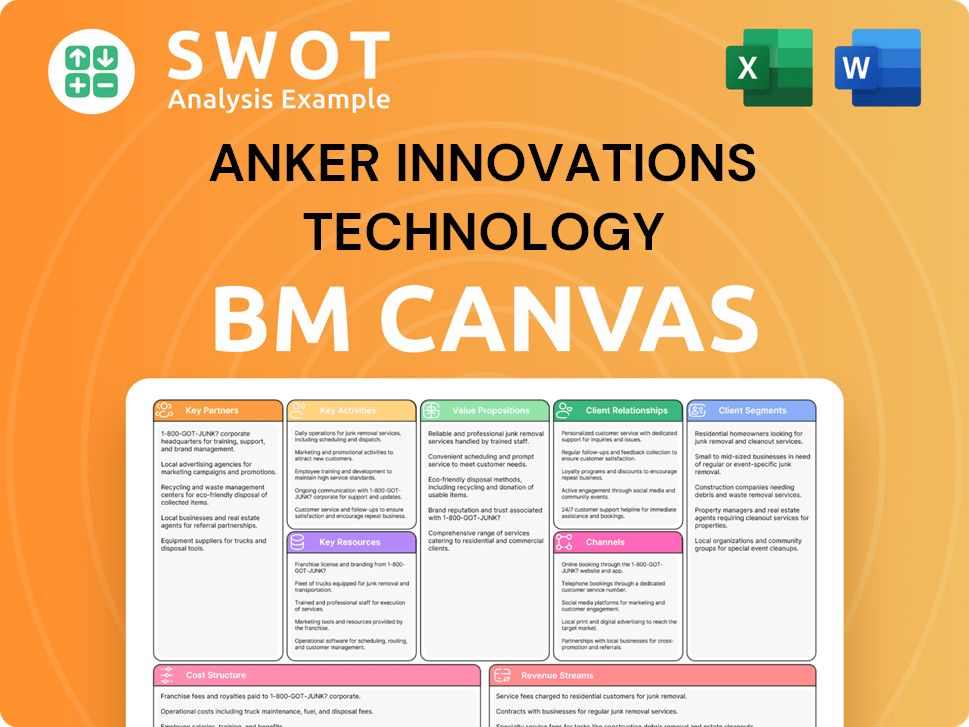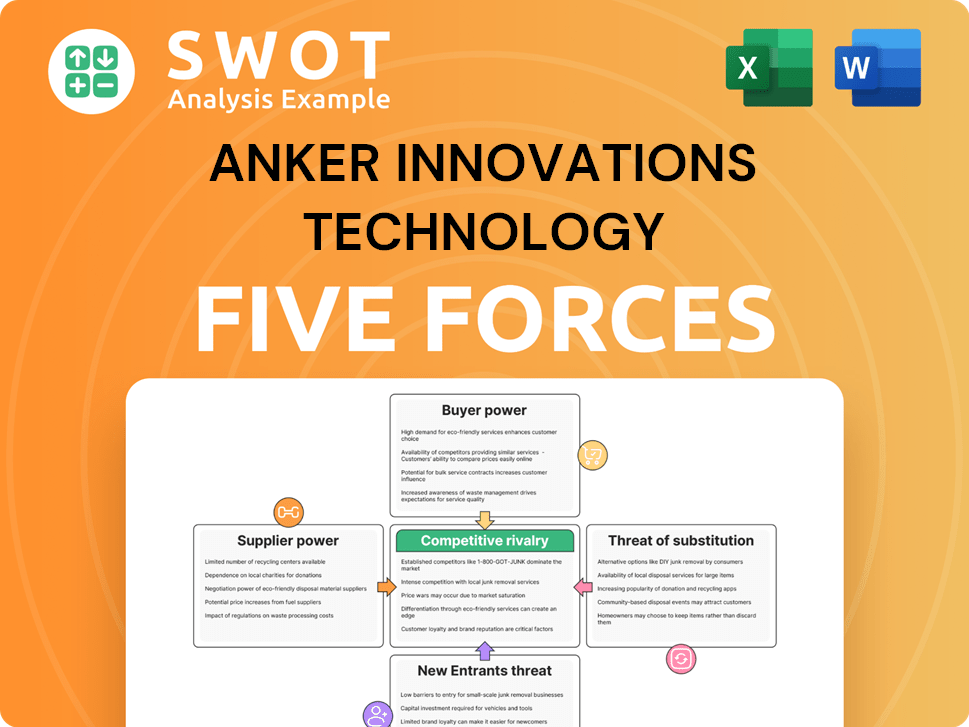Anker Innovations Technology Bundle
Who Buys Anker Innovations Products?
Unraveling the customer profile of Anker Innovations Technology SWOT Analysis is key to understanding its market dominance. From its humble beginnings in 2011, Anker has evolved from a charger provider to a multifaceted consumer electronics powerhouse. This strategic growth necessitates a deep dive into its customer demographics and target market to grasp its ongoing success.

This exploration of Anker Innovations' customer base will reveal the company's ability to adapt to evolving consumer needs. Understanding Anker's ideal customer, including their age range, income levels, and geographic location, is crucial. Through this market analysis, we'll uncover how Anker targets its customers and maintains its competitive edge in the consumer electronics industry.
Who Are Anker Innovations Technology’s Main Customers?
Understanding the customer demographics and target market is crucial for a technology company like Anker Innovations. Their primary focus is on serving consumers (B2C) through a diverse portfolio of brands. This approach allows them to reach a wide array of individuals with varying needs and preferences across different product categories.
Anker's success hinges on accurately identifying and catering to these diverse customer segments. By understanding their target audience demographics, Anker can tailor its product development, marketing strategies, and overall business operations to effectively meet customer needs and preferences. This targeted approach is essential for driving sales, building brand loyalty, and achieving sustainable growth in the competitive consumer electronics market.
The customer profile for Anker Innovations is multifaceted, reflecting its broad product range. Key segments include tech-savvy individuals, music enthusiasts, and homeowners interested in smart home technology. Each segment has unique characteristics, influencing Anker's product offerings and marketing efforts.
The core demographic for Anker's charging solutions often includes tech-savvy individuals, students, and professionals aged 25-45. These customers rely on portable power for their devices. They prioritize reliability and fast charging, typically with a mid-to-high income level.
For its Soundcore audio brand, Anker targets music enthusiasts and active lifestyle individuals. This segment is often aged 18-35. They seek high-quality sound, comfort, and durability in headphones and portable speakers, valuing features like noise cancellation and extended battery life.
Eufy, Anker's smart home brand, appeals to homeowners and families. This segment is generally aged 30-55. They are interested in home automation, security, and convenience, often with a higher disposable income. They prioritize ease of use and integration.
Nebula, the portable projector brand, caters to entertainment enthusiasts and young professionals. They value portability and immersive viewing experiences, often for casual use or small gatherings. This market is a niche segment for Anker.
Anker has observed shifts in its target segments, particularly with the growth of its smart home and audio divisions. The increasing adoption of smart home technology has expanded Eufy's reach. The competitive audio market has pushed Soundcore to target specific sub-segments.
- Anker's customer acquisition strategies include online advertising, social media marketing, and partnerships with retailers.
- The company often uses influencer marketing, especially within the Soundcore and Nebula brands, to reach specific customer segments.
- Anker's marketing campaigns are tailored to each product line.
- Market analysis and product development are key to understanding and meeting customer needs.
Anker Innovations Technology SWOT Analysis
- Complete SWOT Breakdown
- Fully Customizable
- Editable in Excel & Word
- Professional Formatting
- Investor-Ready Format

What Do Anker Innovations Technology’s Customers Want?
Understanding the customer needs and preferences is crucial for the success of any technology company. For Anker Innovations, this involves a deep dive into what drives their diverse customer base, from those seeking reliable charging solutions to individuals desiring immersive audio experiences or smart home automation.
The customer base of Anker Innovations, a leading consumer electronics company, is driven by a blend of practical utility, technological advancement, and a desire for seamless integration into their digital lifestyles. This understanding is essential for effective market analysis and developing products that resonate with their target market.
Anker's approach to product development is heavily influenced by customer feedback and market trends. This customer-centric strategy allows the company to stay ahead of the curve and meet the evolving needs of its consumers. The company's ability to adapt and innovate is a key factor in its continued success in the competitive consumer electronics market.
Customers prioritize reliability, durability, and performance in Anker's charging products. They seek fast, safe, and efficient power delivery, often driven by the need to combat dwindling battery life on their devices. Decision-making criteria include charging speed (like Power Delivery), port variety (USB-C, USB-A), and portability.
Soundcore customers prioritize sound quality, battery life, and comfort. Features like active noise cancellation and multi-point connectivity are also increasingly important. The desire for an immersive audio experience, whether for entertainment, productivity, or fitness, drives their choices.
Customers are motivated by security, convenience, and automation when purchasing Eufy products. They seek easy-to-install devices, reliable performance, and privacy assurances. Practical drivers include monitoring homes, simplifying routines, and enhancing safety.
Anker addresses common pain points such as slow charging, tangled cables, poor audio quality, and complex smart home setups. This is achieved through continuous product innovation and user-centric design, which is a core part of their strategy.
Anker actively uses customer feedback and market trends to influence product development. The demand for USB-C Power Delivery led to an expansion of charging solutions. The rise of true wireless earbuds significantly influenced Soundcore's product roadmap.
The company tailors its marketing to specific segments. For example, showcasing the ruggedness of Soundcore speakers for outdoor enthusiasts. Anker's focus on competitive pricing for high-quality products appeals to value-conscious consumers. This is an important part of their customer acquisition strategies.
Understanding the customer demographics and target market is essential for Anker Innovations' success. The company focuses on providing reliable, high-quality products that meet the specific needs of its diverse customer base. Anker's success is also driven by its ability to adapt to market trends and customer feedback.
- Reliability and Durability: Customers consistently prioritize products that are built to last and perform consistently over time.
- Performance: High-speed charging capabilities, superior sound quality, and efficient smart home automation are key drivers.
- Ease of Use: Products that are simple to set up and operate, with intuitive interfaces, are highly valued.
- Value for Money: Competitive pricing for high-quality products is a significant factor in purchasing decisions.
- Technological Advancement: Customers are drawn to products that incorporate the latest technologies, such as Power Delivery, active noise cancellation, and smart home integration.
Anker Innovations Technology PESTLE Analysis
- Covers All 6 PESTLE Categories
- No Research Needed – Save Hours of Work
- Built by Experts, Trusted by Consultants
- Instant Download, Ready to Use
- 100% Editable, Fully Customizable

Where does Anker Innovations Technology operate?
The geographical market presence of Anker Innovations, a technology company, is significantly global, with a strong focus on major developed economies. The company's success is largely tied to markets where consumer electronics adoption is high, including North America, Europe, and parts of Asia. This strategic focus allows Anker to capitalize on the demand for its consumer electronics products in regions with robust purchasing power and a high propensity for adopting new technologies.
The United States consistently represents a substantial portion of Anker's sales, where it has established strong brand recognition, particularly within the online retail space. In Europe, countries like Germany, the UK, and France are key markets, reflecting a similar consumer profile to North America in terms of technological adoption and purchasing power. In Asia, Japan stands out as a strong market for Anker, known for its discerning consumers and high demand for quality electronics.
Anker's ability to adapt its strategies to different regions is a key factor in its global success. This includes tailoring product specifications, translating marketing materials, and collaborating with local retailers. The company's agile supply chain, effective digital marketing, and commitment to meeting localized consumer needs contribute significantly to its market performance. For a deeper dive into the financial aspects of Anker, consider exploring Revenue Streams & Business Model of Anker Innovations Technology.
The United States is a primary market for Anker, with strong brand recognition. Customer demographics in North America often prioritize features and brand reputation. Anker leverages online retail channels, such as Amazon, to reach this market effectively.
Key European markets include Germany, the UK, and France, mirroring North American consumer profiles. These markets show high technological adoption and purchasing power. Anker adapts its products and marketing to suit European preferences.
Japan is a significant market, known for discerning consumers and high demand for quality. Anker tailors its offerings to meet the specific needs of Japanese consumers. Competitive pricing and localized features may be emphasized.
Anker heavily relies on online retail, particularly platforms like Amazon, for global reach. This strategy is crucial for reaching its target market. Effective digital marketing and agile supply chains support this approach.
Anker Innovations Technology Business Model Canvas
- Complete 9-Block Business Model Canvas
- Effortlessly Communicate Your Business Strategy
- Investor-Ready BMC Format
- 100% Editable and Customizable
- Clear and Structured Layout

How Does Anker Innovations Technology Win & Keep Customers?
The technology company, Owners & Shareholders of Anker Innovations Technology, focuses heavily on digital channels for acquiring and retaining customers. Their strategy combines online retail presence, social media engagement, and partnerships with tech influencers. This multi-faceted approach helps them reach their target market effectively and build brand loyalty.
Digital advertising, particularly on Google and Facebook, is a cornerstone of their customer acquisition efforts. They also use email marketing to engage with existing customers and promote new products. By analyzing customer data, they personalize product recommendations and marketing messages, enhancing the customer experience and driving repeat purchases.
Competitive pricing, bundled offers, and flash sales are common sales tactics on e-commerce platforms. The company's direct-to-consumer model through its own websites also plays a role in building brand loyalty. The company's commitment to customer satisfaction, through responsive customer support and robust product warranties, fosters trust and encourages repeat purchases.
Digital advertising campaigns on platforms like Google and Facebook are crucial for reaching targeted customer segments. This includes the use of search engine optimization (SEO) to improve organic search rankings. In 2024, digital ad spending in the consumer electronics sector is projected to be around $10 billion in North America alone.
Sales tactics often involve competitive pricing, bundled offers, and flash sales on e-commerce platforms, particularly on Amazon. In 2024, Amazon's net sales are expected to reach approximately $650 billion, with a significant portion coming from consumer electronics.
By analyzing purchase history, product registrations, and website interactions, the company can personalize product recommendations and marketing messages. Data from 2024 indicates that personalized marketing can improve conversion rates by up to 10%.
Excellent after-sales service, including responsive customer support and robust product warranties, is a key factor in customer retention. Companies with strong customer service see, on average, a 15% increase in customer lifetime value.
The strategies used by the technology company to acquire and retain customers are multifaceted and data-driven. These strategies are essential for understanding the customer demographics and the target market.
- Digital Marketing: Utilizing platforms like Google and Facebook to reach targeted customer segments.
- E-commerce Tactics: Employing competitive pricing, bundled offers, and flash sales.
- Customer Data Analysis: Personalizing marketing messages based on purchase history and website interactions.
- Customer Service: Providing excellent after-sales service, including responsive customer support and robust product warranties.
Anker Innovations Technology Porter's Five Forces Analysis
- Covers All 5 Competitive Forces in Detail
- Structured for Consultants, Students, and Founders
- 100% Editable in Microsoft Word & Excel
- Instant Digital Download – Use Immediately
- Compatible with Mac & PC – Fully Unlocked

Related Blogs
- What are Mission Vision & Core Values of Anker Innovations Technology Company?
- What is Competitive Landscape of Anker Innovations Technology Company?
- What is Growth Strategy and Future Prospects of Anker Innovations Technology Company?
- How Does Anker Innovations Technology Company Work?
- What is Sales and Marketing Strategy of Anker Innovations Technology Company?
- What is Brief History of Anker Innovations Technology Company?
- Who Owns Anker Innovations Technology Company?
Disclaimer
All information, articles, and product details provided on this website are for general informational and educational purposes only. We do not claim any ownership over, nor do we intend to infringe upon, any trademarks, copyrights, logos, brand names, or other intellectual property mentioned or depicted on this site. Such intellectual property remains the property of its respective owners, and any references here are made solely for identification or informational purposes, without implying any affiliation, endorsement, or partnership.
We make no representations or warranties, express or implied, regarding the accuracy, completeness, or suitability of any content or products presented. Nothing on this website should be construed as legal, tax, investment, financial, medical, or other professional advice. In addition, no part of this site—including articles or product references—constitutes a solicitation, recommendation, endorsement, advertisement, or offer to buy or sell any securities, franchises, or other financial instruments, particularly in jurisdictions where such activity would be unlawful.
All content is of a general nature and may not address the specific circumstances of any individual or entity. It is not a substitute for professional advice or services. Any actions you take based on the information provided here are strictly at your own risk. You accept full responsibility for any decisions or outcomes arising from your use of this website and agree to release us from any liability in connection with your use of, or reliance upon, the content or products found herein.